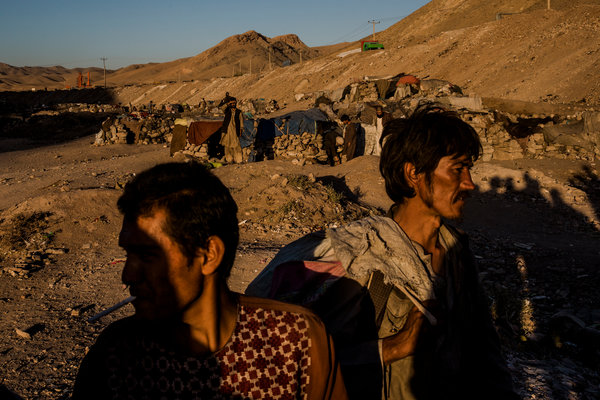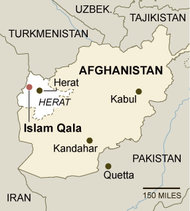
- Daniel Berehulak for The New York Times
Reeling From War, Afghan Society Ill-Equipped to Face Addiction: Afghanistan’s western border towns with Iran have become veritable zombie villages in recent years — encampments where entire families are shambling addicts.
New York Times By AZAM AHMED
ISLAM QALA, Afghanistan — The addicts stalk the streets of this border post like hollowed-out skeletons, hair matted by filth and eyes glassy. The villages that hug the roads are veritable zombie towns, where families of men, women and children hide their addiction within barren mud compounds.
“Sometimes I feel it is better to die than live like this,” said Haidar, 30, seated on the floor of his living room beside a small tin of sugarlike powder.
His family, a wife and young children, bore the gaunt faces of addiction as well.
In western Herat Province, held up as an island of stability and progress in Afghanistan, this forlorn border town is instead a showcase for an intensifying crisis: Long the global leader in opium production, Afghanistan has now also become one of the world’s most addicted societies.
The number of drug users in Afghanistan is estimated to be as high as 1.6 million, or about 5.3 percent of the population, among the highest rates in the world. Nationwide, one in 10 urban households has at least one drug user, according to a recent report from the Bureau of International Narcotics and Law Enforcement Affairs. In the city of Herat, it is one in five.
From 2005 to 2009, the use of opiates doubled, according to the United Nations Office on Drugs and Crime, putting Afghanistan on par with Russia and Iran, and the number of heroin users jumped more than 140 percent. Most drug experts think the rate of drug use has only increased since then.
In a country troubled by adversity, from its long-running war to rampant corruption, drug addiction ranks low among national priorities. Government funding for treatment and outreach is less than $4 million a year. There are just under 28,000 formal treatment slots available nationwide, officials say, and such programs rely heavily on roughly $12 million a year in extra international funding for treatment.
The focus of the international community and the Afghan government has instead been on reducing opium production. Since the beginning of the war in 2001, the Americans have spent more than $6 billion to curb Afghanistan’s opium industry, including eradication and alternative crop subsidies. The effort has struggled, and in many areas eradication efforts have been unofficially abandoned as too costly in terms of lost public support for government.
In the last two years, opium cultivation has increased to the highest level since 2008, as global demand and prices remain robust.
The sheer volume of supply has fueled domestic demand, a phenomenon the United Nations drug czar in Afghanistan refers to as “the Coca-Cola effect,” after the company’s market-saturation tactics.
Cementing the status quo is a lack of treatment options, like methadone substitution, or a holistic plan to address the crisis.
“This is a tsunami for our country,” said Dr. Ahmad Fawad Osmani, the director of drug demand reduction for the Ministry of Public Health. “The only thing our drug production has brought us is one million drug users.”
While it has grown far worse in the past few years, the drug crisis in Afghanistan is not new. International health officials caught on early to the problem, which in some measure stemmed from the traditional use of opium for medication.
In fact, one of the earliest challenges Afghan security forces had to surmount was a public image as a band of opium-addled thieves.
The problem, while more controlled, still exists: Just last month, the nation’s intelligence agency, the National Directorate of Security, fired 65 employees after discovering they were addicted to opium.
In rural areas, the problem is expected to be worse. In some villages, the rate of drug use is as high as 30 percent of the population, based on hair, urine and saliva samples taken by the authors of the urban study. And drugs not traditionally in wide use here, including crystal methamphetamine, are now figuring in the problem as well.
Perhaps nowhere in Afghanistan presents a bleaker picture of addiction than Herat Province. Widely held up as a success story, the province enjoys a booming economy, a relatively progressive society and a vibrant capital free of the trash-strewn streets and waterways that choke most large Afghan cities.
But beneath the surface, Herat is contending with the country’s most serious drug addiction problem.
The head of the counternarcotics ministry in Herat says there are 60,000 to 70,000 addicts in the province, though some health officials figure the number is closer to 100,000. In the capital, roughly 8 percent of the population uses drugs, the new international report found.
The addiction crisis brings with it all manner of problems, including crime and public health concerns. A 2010 report by Johns Hopkins University found that about 18 percent of intravenous drug users in the provincial capital were infected with H.I.V., compared with just 3 percent in Kabul.
Long a staging area for men who work as day laborers in Iran, Islam Qala is now also a frequent waypoint for addicts returning to Herat. Most of the men say they picked up their habits while in Iran. The authorities there, struggling to deal with a widespread drug crisis of their own, are quick to banish Afghan addicts back across the border by the thousands, and the deported people stream back into Islam Qala six days a week.
In Herat’s capital, addicts fill the streets and parks, begging from pedestrians and motorists with relentless persistence. Pockets of the city have been transformed into junkie ghettos, like Kamar Kulagh, a roadside slum of sandbags, rocks and rags.
On a recent day, the faint outline of figures crawled through the bleached landscape, situated to the side of a highway on the northern edge of the city. Broken glass covered the hillside leading down to the encampment.
A makeshift lounge constructed of a discarded truck grill and broken toilet seats offered respite from the sun. The smell of feces wafted through the air.
Azim Niazi, 30, shuffled through the village clutching two bags bulging with empty bottles, recycling them to pay for a drug habit that he said he had picked up as a laborer in Iran.
Wahid Ahmad, 27, who said he had been living there since he was deported from Iran two years ago, joined him.
The two began discussing the death that morning of one of the camp residents, a man they knew only as Reza.
“This is the third day someone has died here,” Mr. Ahmad said, listing the illnesses that plague residents of the camp. He paused, reflecting for a moment as the whir of traffic raced by above. Bloodshot eyes crouched within his gaunt face.
The pair walked deeper into the camp to check on Reza’s body, stretched out in a stone den with a yellowed plastic roof. Reza lay on his back, the bottom of his gray shalwar pulled over his emaciated face. Flies buzzed in and out of the hovel. A heavy perfume masked the decay.
“His friend will die tomorrow,” said Mr. Niazi, pointing to a man, a skeleton cloaked in skin, lying in a sliver of shade nearby.
A man strolled past, carting his 2-year-old daughter in his arms.
Though many of the addicts in Herat came by way of Iran and Islam Qala, others decided to stay nearer the border — or are simply unable to make their own way anymore.
Substance abuse has taken root in the local community too, infecting entire villages around Islam Qala, including young children hooked by secondhand opium smoke.
“The entire region is addicted, whole villages,” said Arbah Shahabuddin, an elder in Islam Qala. “If you take off your shoes, the addicts will steal them.”
To demonstrate the devastation, Mr. Shahabuddin, a homeopathic doctor, offered a tour of the drug villages.
A maze of dirt roads divides the homes, which sit behind high mud walls. Mr. Shahabuddin pointed to the new construction peeking over the walls of select compounds: smugglers’ homes.
“Anyone here that looks clean is a smuggler,” he explained.
House to house, Mr. Shahabuddin went, dragging families from their compounds into the blinding daylight to tell their stories. They stood startled, somewhat incoherent and mostly debilitated by addiction.
At one home, a woman answered the door and ran to collect her husband, Dad Mohammad, who was getting high. Mr. Mohammad, 35, said he had been using heroin for the past seven years. “It’s very easy to find heroin here,” he said.
His wife, Bibi Gul, standing in the doorway of their home, complained that her husband beat her every day and took money from their children to feed his addiction.
Mr. Mohammad, wearing a woolen hat in the midday heat, stared into the distance, smiling.


